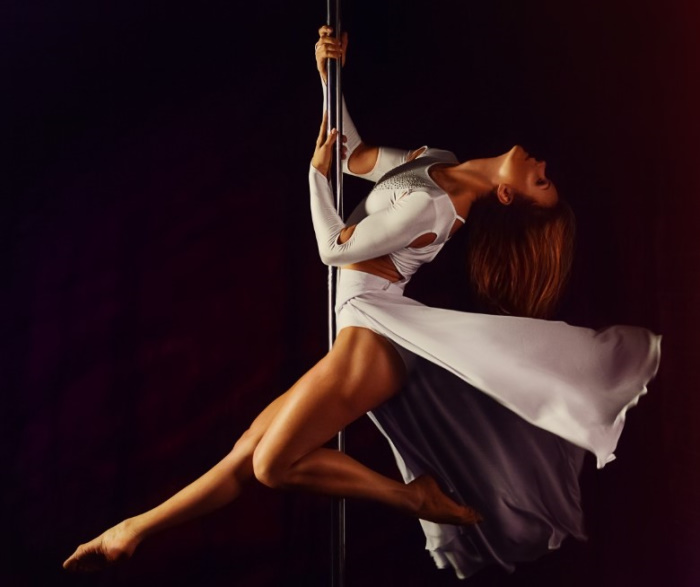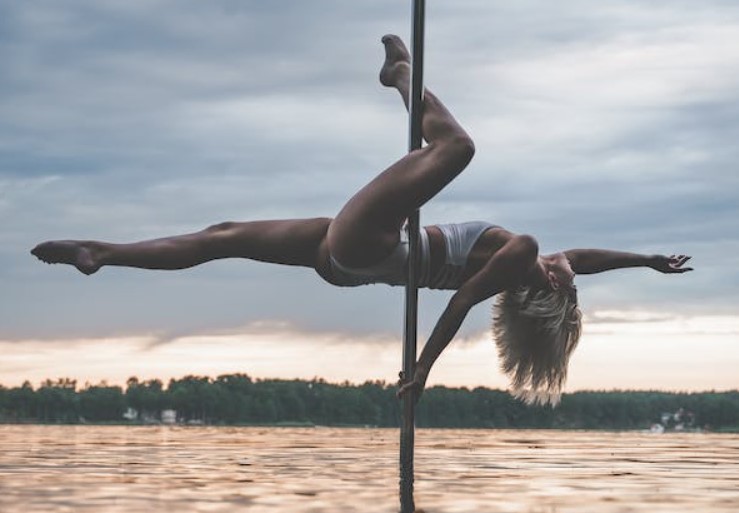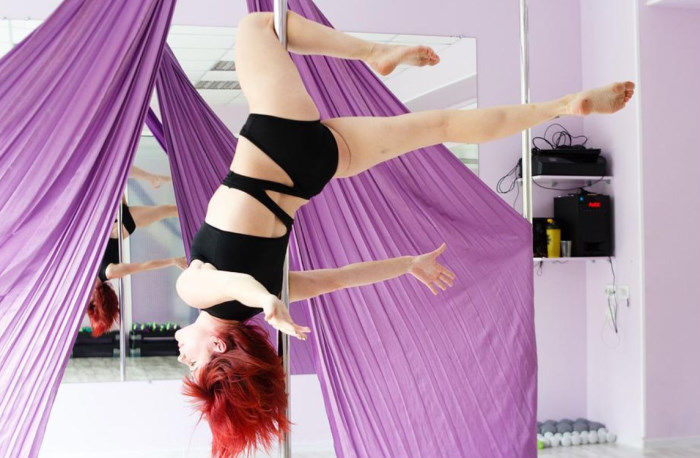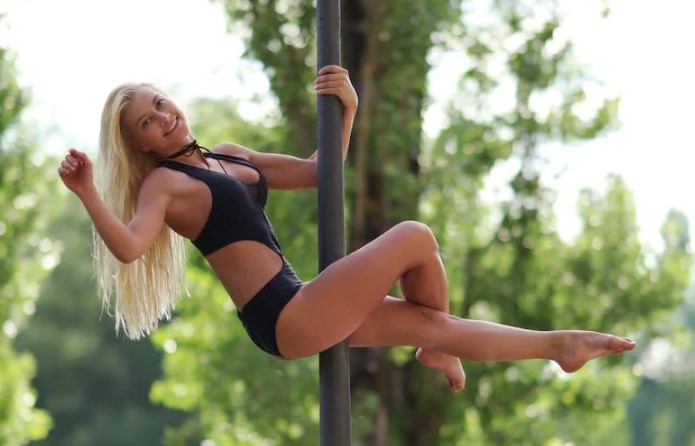Although pole dancing is widely considered to be a legitimate dance form and even a sport (it may even be featured in the Olympics in the future!), there’s still a lot of stigma surrounding it. And if you’ve ever wondered “why is pole dancing bad?”, then you’re not the only one.
Some of the reasons why people steer clear of this dance sport are (relatively) legitimate, while others are rooted in traditionalism and an out-of-date view of pole dancing.
But no matter, in this article, we’ll take a look at them all so you can form your own opinion!
Table of Contents
Why Is Pole Dancing Considered Bad?
Some People Think That Pole Dancing Is Sexualized

Whenever the term “pole dancing” is mentioned, people can’t seem to shake the idea that it’s only ever done in bars and strip clubs.
The dance form is almost synonymous with promiscuity and the sex industry. So it has been criticized by a lot of people over many decades as being degrading or immoral. Some may also consider pole dancing to be a form of objectification and sexual exploitation of the dancers.
Some People Think That Pole Dancing Is Dangerous
This fear is entirely rational.
Some of the moves that professional pole dancers do can be heart-stopping even to watch, let alone do. For example, in the aerial invert, the dancer can climb high on the pole (several feet off the ground), then contort their body so that they’re entirely upside down, with their legs splayed to either side of their body.
It’s not hard to imagine how badly the dancer could be injured if they fell accidentally.
However, it’s worth noting that only veteran pole dancers with years (even decades) of experience would perform these tricks. They have the training and the technique to prevent themselves from falling.
Pole dancing is a safe and simple sport for most beginners and casual hobbyists. If you don’t want to, you don’t have to learn to perform advanced moves like the aerial invert, the ankle hangs, or the Ayesha.
And if you’re afraid of height, you can tell your instructor, and they’ll show you great, beautiful moves where you don’t even have to be above the ground more than a couple of inches.
Practicing and performing basic and safer moves won’t make you any less of a good dancer!
Main Reasons Why People Quit Pole Dance
These are the two “classic” reasons. But these days, not a lot of people worry about sexualization or “looking like it’s dangerous” anymore.
As people grow and become more tolerant, pole dancing has slowly gained traction among the public as a legitimate kind of dance sport.
But there are still reasons for people to either avoid or quit pole dancing.
Pole Dancing Risks
Now, as much as we love and respect pole dancing as a brilliant kind of dance sport, we would be lying if we say that it’s not dangerous.
Even if you don’t do advanced moves like the ones we listed above, there’s still some risk of getting injured. This is the reason why you’ll need to have a spotter or a good dance instructor showing you the rope and ensuring that you’re practicing (and performing) safely.
Here are some common injuries that pole dancers face.
Pole Kisses
When you pole dance, your body may become banged, slammed, or hit as you work your way up, down, and around the pole. If you’re a new dancer, there’s a good chance that you’ll come home after every practice with a couple of bruises on your body. These are called “pole kisses” by dancers.
As you gain more experience and develop a better grip on the pole, kisses will be rarer (but they won’t disappear entirely, think of it like an occupational hazard.)
Injuries
As with most forms of risky dances like pole dancing, injuries are unavoidable. From fall injuries, and sprained wrists and ankles, to bruises, and scratches, of all kinds… we’ve seen it all at dance studios.
Fortunately, all of these injuries are entirely preventable. Before you practice, do a proper round of warm-ups and get into stretching habits.
Falling
A standard pole is about 8 feet tall. Most beginners won’t have to go a foot or two up on the pole, while advanced dancers can climb 5-6 feet up to execute their tricks. In any case, there’s always a risk of falling when you lift your feet off the ground.
There are many locking tricks to help you secure your body and prevent you from falling off the pole, but accidents do happen.
That’s why, no matter where you practice, either at home or at dance studios, ensure that there are high-quality crash mats underneath the pole. Crash mats will protect you from being hurt too badly even on the off chance that you slip and fall.
Pole Dancing Injuries
When you practice or perform pole dancing, that means accepting the risk that you could be injured.
Yes, pole dancing is great for your health. It can strengthen your core muscles and make you healthier overall. But when accidents happen or if you don’t have the proper technique, it’s very easy to get injured.
Here are some common injuries that pole dancers of all levels can face while practicing or performing.
Upper Body Injuries
If you don’t execute drops and leaps well, they could easily result in a nasty elbow injury. Certain moves such as the flag movements are known to injure the joints and muscles in your shoulders.
Because your hands are how you grip and move along with the pole, just about every move in pole dancing requires your wrist for support and stability and your fingers for grip. Without the right technique or if you push your body too far, you may end up with a dislocated joint or a pulled muscle.
This is why practicing the right technique with a good instructor is so important.
Lower Body Injuries
A lot of pole dancers wear heels or platform shoes when they perform. These footwears are already uncomfortable to walk in, but it’s an entirely different level of discomfort when you have to dance in them. Because they lack support for the ankle, you can easily pop out your ankle when you dance.
It’s not impossible to dance in heels or platform shoes. Just about every pole dancer has learned how to perform in them. But “learn” is the keyword here: if you want to dance safely in heels and platform shoes, you’ll need the proper knowledge and good technique.
So, if you know you’re going to perform in heels, practice for a couple of weeks in them beforehand to get used to them. Ask your instructors for pointers on how to balance and dance in them, too.
Pole dancing has also been said to be bad for knees. And it’s not wrong: falls can also affect your knee joints. But this will only happen if you don’t land correctly. The secret is pretty simple: learn and practice how to land with your knees flexed. If you lock your knees, then your ligaments will suffer.
With the right landing technique, pole fitness can be very beneficial for your knee joints’ health!
Check more: 7 Best Knee Pads For Dancers To Avoid Injuries
Spinal Injuries
Spinal injuries are the most serious kind that a pole dancer can get. A back injury is inevitable if you don’t train or practice well.
Executing spins, performing repellents, and jumping onto and off the pole can cause immense pressure on the vertebrae of your spine. At best, you’ll have bruises along your back and sore muscles due to excessive strains. If the injuries are serious enough, your lumbar can be damaged.
In pole dancing, you’ll need to flex and stretch your body a lot. And as you go up the levels and practice more advanced and complicated moves, you may inadvertently push your body to its utter limit. When that happens, you’ll be at risk of getting micro and macro injuries to your intervertebral discs and their vertebrae.
Once again, this is why practice and good instructors are important.
Back injuries aren’t trivial problems. They can result in chronic pain and long-term physiological issues if you keep pushing your body beyond its breaking point. Many pole dancers have to quit because they end up with a career-ending back injury.
Forget Those Risks, What Does Pole Dancing Really Do To Your Body?
But if you’re willing to brave these risks, practice regularly and have the help of good instructors, then pole dancing can bring a lot of benefits to your body and mind.
Better Physical Strength and Flexibility
Pole dancing is a full-body workout. In order to become a competent pole dancer even at the most basic levels, you need to develop strength and flexibility in all parts of your body.
A pole dancer’s exercises will target all the major muscle groups in the body, from the shoulders down to the feet. Exercises include climbs, spins, and inversions which require strength and flexibility to perform correctly.
So, if you practice pole dancing regularly in any capacity (either as a side hobby or a serious skill), you’ll find that your physical strength and flexibility gradually improve over time.
Pole dancing is often aerobic in nature, meaning it helps with endurance levels too.
Increased Endurance, Balance, and Coordination
Pole dancing requires intense concentration, body control, coordination, and balance to perform movements such as inverts, climbs, reverses, spins, holds, and drops.
And considering how so many moves require the dancer to contort and flex their bodies, it’s not surprising to learn that pole dancing also helps with flexibility.
This is why pole fitness is a great choice for athletes looking to increase their physical prowess and technique and recreational dancers looking for a fun way to stay fit!
Develop Discipline and Focus
Pole dancing requires a great deal of discipline and focus. As we said earlier, even the most basic moves in pole dancing require hours and days of consistent practicing and training. Not many people are disciplined and focused enough to spend so much time practicing!
Additionally, pole dancers need intense concentration to handle difficult maneuvers. Advanced moves are so risky that the dancer risks sustaining a bad injury if they fall or do it incorrectly.
Discipline can also come into play regarding strength building through weight training and cardiovascular fitness exercises. Practicing pole dancing alone is often not enough. You also need to train your body outside the dance studio to have an easier time doing difficult movements.
Boost Confidence
Learning how to move in new ways can boost your sense of empowerment.
Plus, achieving difficult moves and tricks can also give you a huge sense of accomplishment. Other than being rewarding and great for your mental well-being, it also builds strong self-esteem.
Finally, utilizing costumes or makeup for performances can help you learn how to express yourself freely and discover parts of yourself that you never knew before.
Help You Socialize
Pole dancing can be a great way to socialize with others.
When you’re in the studio, you’re surrounded by people there for the same purpose as you. That’s an excellent ground for striking up conversations and making new friends!
Everyone in the studio will also have their unique style of pole dancing that can inspire and motivate each other. With every new trick or spin, someone will surely have guidance and tips for improving.
There are often dance events and competitions where pole dancers jam or compete against each other. This is yet another opportunity that pole dancing presents for you. Take advantage of it and expand your network further than the friends you’ve already made at the studio!
How To Avoid Pole Dancing Risks
Risks are plentiful in pole dancing, but there are steps that you can take to minimize them. Here’s a checklist that you can follow:
- Never forget to warm up before you practice or perform. By stretching out your muscles and joints beforehand, the risk of you getting an injury will be much lower.
- Proceed at a pace that suits your skill level. Don’t try to practice advanced moves when you’re still at a beginner or intermediate level. Trust us, it’s not worth it.
- Wear appropriate clothing to provide adequate skin protection while performing tricks. Avoid any items of clothing that impede movement.
- Use crash pads and training poles designed to reduce the risk of impact injuries in case of slips or falls if you practice at home. Most studios will already have this equipment in place. If yours doesn’t, ask them to provide the safety gear for you.
- If available, take pole dancing classes with a qualified instructor who understands the appropriate technique and progressions for each move. It’ll help you to avoid incorrect forms which can cause stress on your joints and muscles.
- Strengthen core muscles as these will assist with balance and ease of movement on the pole. You can take physical training at home or at a gym.
- Rehydrate while exercising to prevent heat exhaustion or stroke. When you’re dehydrated, your focus will be less sharp and it’ll be a lot easier to make mistakes, some of which can quite literally hurt.
- Always listen to your body and modify your practice plan if you feel abnormally achy and sore after a session. Discuss with your instructor and ask for a few pointers. If the pain you feel is concerning, don’t hesitate to go to a doctor.
Final Verdict
So, is pole dancing a bad thing? The answer is simple… it’s not. All of the stigmatizations surrounding pole dancing are mostly because of an antiquated view that it’s a sexualized dance and not a “real” sport.
Many people use pole fitness as a way to keep themselves fit and improve their strength, dexterity, and flexibility. And with the Olympics being well on the way of incorporating pole dancing into the competition… the idea that pole dancing isn’t a real sport is just plainly wrong (with citations!)
If you’re looking to get into pole dancing, don’t let anybody’s opinion prevent you from getting into this excellent sport!



